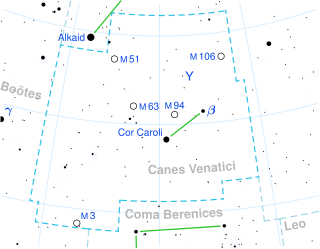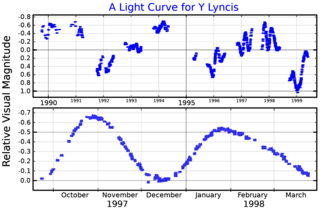
R Hydrae, abbreviated R Hya, is a single star in the equatorial constellation of Hydra, about 2.7° to the east of Gamma Hydrae. It is a Mira-type variable that ranges in apparent visual magnitude from 3.5 down to 10.9 over a period of 389 days. At maximum brightness the star can be seen with the naked eye, while at minimum a telescope of at least 5 cm is needed. This star is located at a distance of approximately 410 light-years from the Sun based on parallax measurements, but is drifting closer with a radial velocity of −10 km/s.

La Superba is a strikingly red giant star in the constellation Canes Venatici. It is a carbon star and semiregular variable.

S Monocerotis, also known as 15 Monocerotis, is a massive multiple and variable star system located in the constellation Monoceros. It is the brightest star in the Christmas Tree open cluster in the area catalogued as NGC 2264.

TX Piscium is a variable red giant star in the constellation Pisces. It is amongst the reddest naked eye stars, with a significant reddish hue when seen in binoculars. It is approximately 800 light years from Earth.

V602 Carinae is a red supergiant and variable star of spectral type of M3 in the constellation Carina. It is one of largest known stars.

S Canis Minoris is a variable star in the equatorial constellation Canis Minor. It has a peak apparent visual magnitude of 6.5, so not normally visible to the naked eye. The star is located at a distance of approximately 1,360 light-years from the Sun based on stellar parallax, and is drifting further away with a radial velocity of about +68 km/s.

Y Centauri or Y Cen is a semiregular variable star in the constellation of Centaurus.

RY Sagittarii is a yellow supergiant and an R Coronae Borealis type variable star in the constellation Sagittarius. Although it ostensibly has the spectrum of a G-type star, it differs markedly from most in that it has almost no hydrogen and much carbon.

T Ursae Minoris is a variable star in the constellation Ursa Minor, located 2′30″ west-southwest of 3 Ursae Minoris toward the western border of the constellation with Draco.

BH Crucis, also known as Welch's Red Variable, is a star in the constellation Crux. A long period (Mira-type) variable, its apparent magnitude ranges from 6.6 to 9.8 over 530 days. Hence at its brightest it is barely visible with the unaided eye in a rural sky. A red giant, it had been classified ranging between spectral types SC4.5/8-e and SC7/8-e, but appears to have evolved into a C-type spectrum by 2011.

EV Carinae is a red supergiant and pulsating variable star of spectral type M4Ia in the constellation Carina. It is a semiregular variable star with its apparent magnitude varying between 7.4 and 9.0 in the visible band, making it only seen by binoculars or a telescope. Various periods have been identified, but the dominant one is around 347 days. It is an MK spectral standard star for the class M4.5Ia.

Y Lyncis is a semiregular variable star in the constellation Lynx. It is an asymptotic giant branch star of spectral type M6S, with a luminosity class of Ib, indicating a supergiant luminosity. It is around 1,160 light years away.

BC Cygni is a red supergiant and pulsating variable star of spectral type M3.5Ia in the constellation Cygnus.

RW Cygni is a semiregular variable star in the constellation Cygnus, about a degree east of 2nd magnitude γ Cygni. Its apparent magnitude varies between 8.05 and 9.70 and its spectral type between M3 and M4.

BI Cygni(BI Cyg, IRC +40408, BD+36 4025) is a red supergiant in the constellation Cygnus. It is an irregular variable star with a maximum brightness of magnitude 8.4 and a minimum of magnitude 9.9. It is considered a member of the stellar Cygnus OB1 association, its distance is around 2,600 parsecs (8,500 ly) of the Solar System. It is less than a degree south of another variable red supergiant, BC Cygni.

S Cassiopeiae is a Mira variable and S-type star in the constellation Cassiopeia. It is an unusually cool star, rapidly losing mass and surrounded by dense gas and dust producing masers.

V528 Carinae is a variable star in the constellation Carina.

TU Andromedae is a variable star of the Mira type in the constellation Andromeda. It has a spectral type of M5e and a visual magnitude which varies between extremes of 7.6 and 13.5.

T Leporis is a variable star in the constellation of Lepus, the Hare. It is located half a degree from ε Leporis in the sky; its distance is approximately 1,100 light years from the Solar System. It has the spectral type M6ev, and is a Mira variable — as is R Leporis, in the same constellation — whose apparent magnitude varies between +7.40 and +14.30 with a period of 368.13 days.
HD 193373 is a solitary red hued star located in the equatorial constellation Delphinus. It has an apparent magnitude of 6.21, placing it near the limit for naked eye visibility. Parallax measurements place it 846 light years distant and it is currently receding with a heliocentric radial velocity of 22.7 km/s.
















